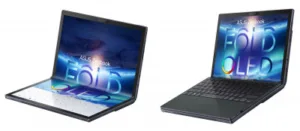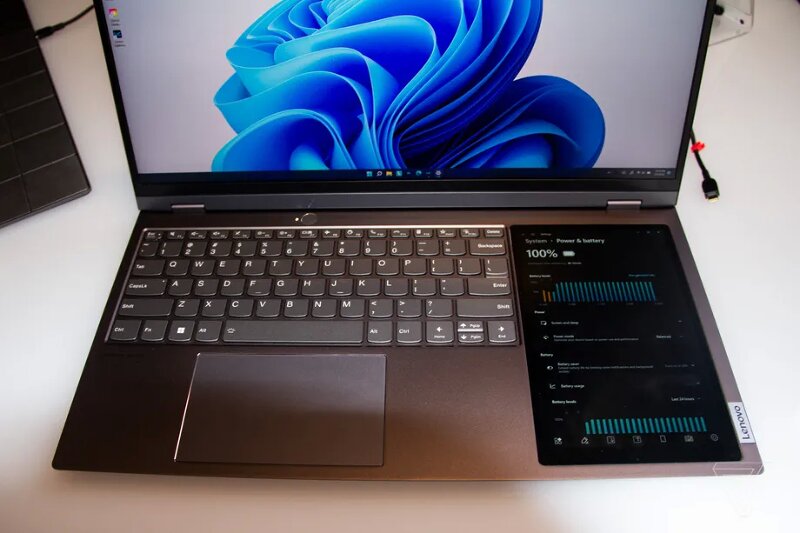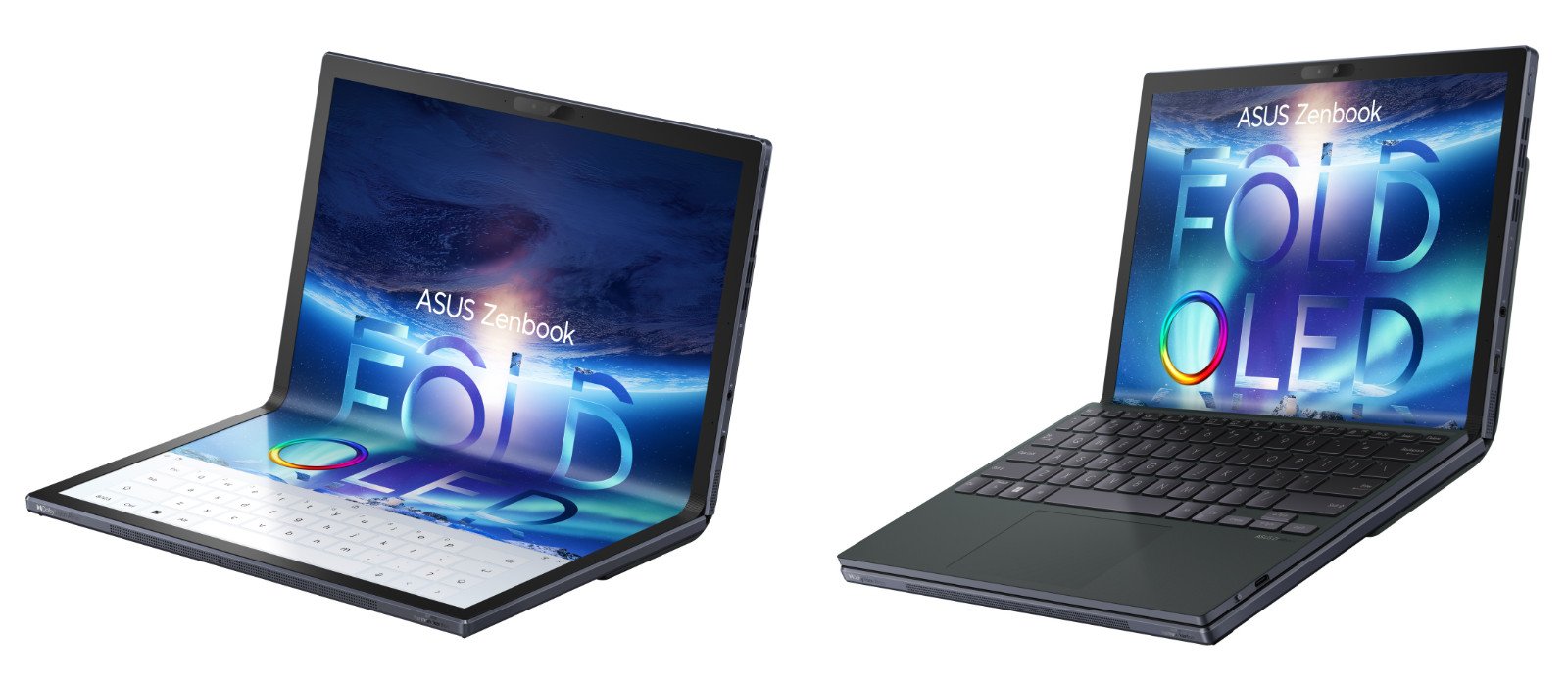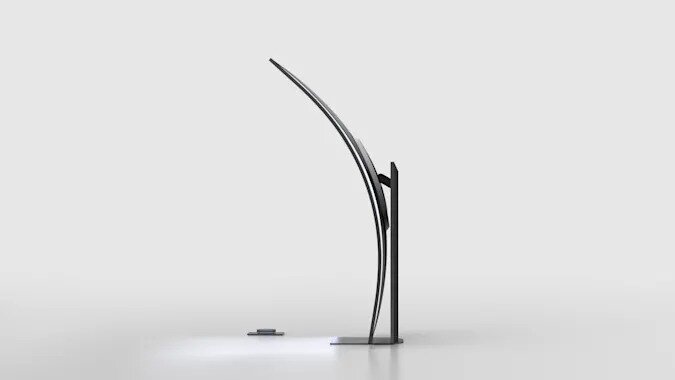We’ve covered TV a lot in our CES coverage, but there was plenty happening in IT displays at this year’s CES. I’ve written other Display Daily articles about the challenges of using OLEDs in IT (OLEDs Into IT – the Whys & Wherefores) and also how advances in OLED technology should help the application. (OLEDs Getting Better Efficiency for IT Applications)

Of course, the big display story at CES was QD OLED and we have already reported on the 34″ monitor that was shown by Dell/Alienware (and due from Samsung Electronics) and which impressed all those that saw it. (New Display Technology QD-OLED Dazzled CES 2022) Samsung Display is saying that QD OLED will have better lifetimes than WOLED, but we’ll have to see how that works out. It’s certainly an area of concern for IT applications where bright fixed images on the screen are endemic. This was one of the factors that was reported to have caused Dell to withdraw its earlier OLED monitor. Another factor was that earlier OLEDs had less than perfect viewing angles, with some colour shift when viewed off-axis. That is acceptable on some displays, but not on the most expensive monitors.
One of the advantages of QD-OLED is that although it has a filter structure on top of the QDs to minimise the excitation of the dots by ambient light, the filter is relative light and seems to have less effect on viewing angle than the resonant cavities used on earlier OLEDs. Certainly, reports from CES point to very good viewing angles from QD OLED.
Anyway, as we have been reporting, Samsung Display (SDC) is looking to boost its sales of OLEDs for the IT applications of tablets, notebooks and monitors as it tries to build demand. That would help to justify the likely building of a new G8.5 fab for making IT panels.
Lenovo Has A Lot of OLEDs
Lenovo had a ‘virtual showcase’ of its new products at CES. The ThinkPad X1 Yoga Gen 7 (convertible) PC has a new 14″ 3840 x 2400 (16:10) OLED with touch. The impressive specification of 500 cd/m² of output, 100% of DCI-P3, HDR400, Dolby Vision and Touch in the OLED model should make it very attractive (although there are 1920 x 1200 LCD options, too, including one with a privacy guard). The X1 Yoga has had OLED options since 2016, but the move to 16:10 in Gen 6 meant a switch to IPS from the 3840 x 2160 16:9 OLED in previous generations.
The ThinkPad X1 Carbon Gen 10 also has a 14″ 2880 x 1800 OLED non-touch option, although it is one of seven different displays available, with the highest resolution 3840 x 2400 option uses IPS LCDs. Slightly surprisingly, the ThinkPad X1 Extreme Gen 4 only has LCD options at 2560 x 1600 and 3840 x 2400 (the Gen 3 had OLED options).
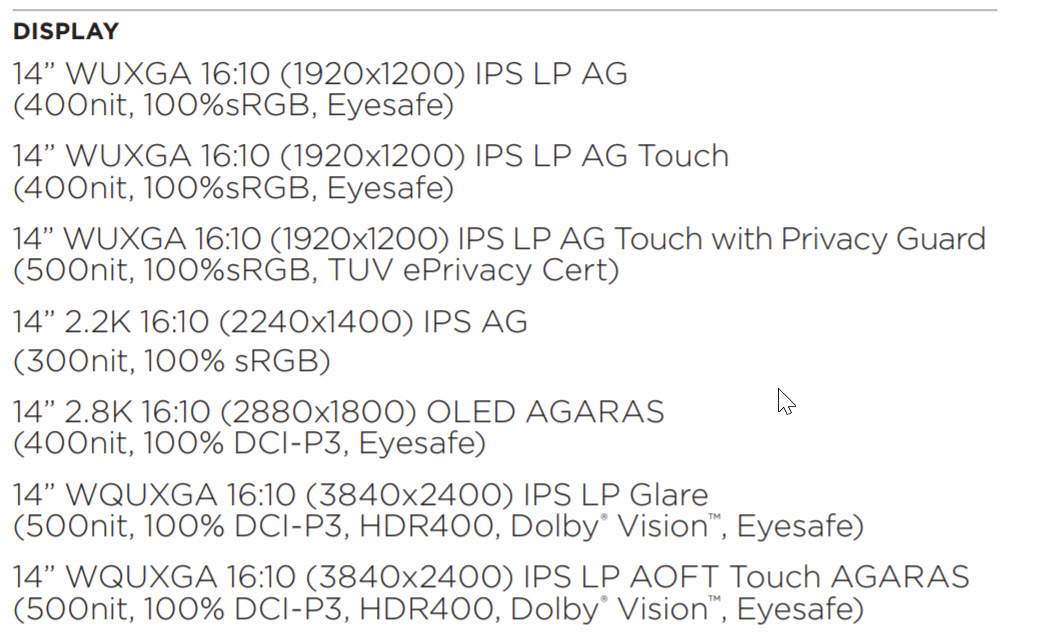 The ThinkPad X1 Carbon Gen10 has seven display options
The ThinkPad X1 Carbon Gen10 has seven display options
The X1 Fold is not new, but, of course, the folding 13.3″ 2048 x 1536 OLED remains an impressive concept. The ThinkBook Plus Gen 3 is another eye-catcher, combining a 17.3″ 120Hz 21.33:10 (my calculation) 3072 x 1440 resolution main display with 196 ppi – about the same as a 15″ 2560 x 1440 panel, with an 8″ pen-enabled touch display with 800 x 1280 resolution alongside the keyboard. That’s different from earlier ThinkBook Plus models, which combined their main displays with external E Ink displays. Sadly, neither of the displays are OLEDs, but it looks like an interesting idea.
In the ThinkVision monitor area, Lenovo had a new IPS P27u-20 UltraHD for professional content creation, with 99.1% of DCI-P3 and 99.5% of AdobeRGB along with DisplayHDR 400 support. It also had the P27h-30 which is a 27″ QuadHD productivity monitor.
Intriguingly, not shown in the Virtual showcase as far as I could see, but probably because it was released before the show, the Lenovo IdeaPad Duet 5 is a Chromebook convertible/tablet with a detachable keyboard and with a 13.3″ 400 cd/m² FullHD Samsung OLED display with full support for DCI-P3 and built around a Snapdragon processor. The device costs $499.
In the Lenovo Legion gaming line-up, everything was based on LCD although the range includes a new 16″ display with 2560 x 1600 and 240Hz adaptive refresh in the Legion 5 Pro series and with support for DisplayHDR 400.
Dell Updates the XPS13
Dell had its Alienware 34″ but also updated its highly regarded XPS 13 Plus which has four display configurations, two of them OLEDs. It also has a capacitive row of function buttons, rather than mechanical switches, to, apparently, allow a higher power processor. The display options include a 3456 x 2160 ‘Infinity Edge’ OLED touch display with 100% of P3 and certification to DisplayHDR 500 and using Corning’s Gorilla Glass 7 for protection. The LCD high res option has 3840 x 2400 resolution and support for DisplayHDR 400. There are 1920 x 1200 options with LCD, too.
Dell also had a 32″ videoconferencing monitor, the U3223QZ, based on LG’s IPS Black technology, which boosts native contrast, the first product I have seen to claim this so far. It supports DisplayHDR 400
Asus the First with a 42″ OLED Monitor
Asus highlighted OLEDs with new 42″ and 48″ OLED monitors. The 42″ is the first monitor to be launched using the new size of WOLED panel from LG, I think, but I doubt it will be the last. The PG42UQ and PGPG48 UQ are said to have a micro-texture coating to reduce reflections and have peak brightness of 900 cd/m². The monitors have a special heatsink and optimised airflow to keep temperatures below 50 deg C, and claimed to be 16% lower than competitors. Colour accuracy is claimed to be with a Delta E of less than 2 and 98% of DCI-P3 coverage.
Asus also had a 360Hz 1440p 27″ IPS LCD display, the PG27AQN, designed for eSports. Intriguingly, the monitor is said to have a dual scan feature. Rather than simply being driven from the top left to the bottom right, it is said to drive in two different directions simultaneously. The panel is also said to use new LC material with higher birefringence and lower viscosity to further improve response times.
The ZenBook 17 Fold OLED follows the kind of form factor used by the ThinkPad Fold, but has a 17″ 2560 x 1920 pixels with 90Hz and certified to DisplayHDR 500 True Black as well as having Pantone certification. The unit can use the display as a keyboard and has a separate keyboard that can sit inside the unit when folded.
The Asus ZenBook 14X OLED Space Edition is a special edition notebook with a 14″ 16:10 2880 x 1800 OLED display with peak output of 550 cd/m² and certified to DisplayHDR 500 True Black as well as covering 100% of DCI-P3 and being Pantone validated. As well as the main display, there is a 3.5″ 256 x 64 OLED ‘companion display’ with 150 cd/m² of output.
The Asus ROG Zephyrus Duo 16 is the firm’s dual display notebook. It has a new exclusive display developed by BOE that is described as ‘dual spec’ with operation at either UltraHD at 120Hz or at FullHD resolution with 240Hz. There is also an optional QuadHD miniLED panel with 165Hz and certification to DisplayHDR 1000.
Asus has long been promoting external USB monitors and at CES it showed three, two (14″/15.6″) based on FullHD IPS LCDs. The MQ16AH is a 15.6″ P3 DisplayHDR 400 True Black FullHD OLED monitor. It has an integrated ambient sensor to dim the image when the display is not in use. It will be available for $399 in Q1 this year.
(When I started this article, I hadn’t spotted these interesting developments, so if I can get more information, I’ll return to this topic).
ROG Strix SCAR is available in 15-inch and 17-inch models, with the 15-inch offering three IPS display choices: QHD 240 Hz, Full HD 300 Hz, and QHD 165 Hz.
Acer is another monitor and PC firm that has done well in gaming and introduced a 48″ CG48 D monitor with refresh of 138Hz
HP Adds a 40″ Curved Monitor
HP had new notebooks in the Dragonfly G3 range that have a 13.5″ display with a 3:2 aspect ratio. There were new conferencing monitors (E24m, E27m, and E34m) and webcam monitors (M24 and M27). There were also 34″ and 40″ curved monitors. The 40″ (39.5″) size is a new one, I think and has a curvature of 2500R with resolution of 5120 x 2160. Although I spotted some comments that the display only supports 30Hz refresh, I checked the HP user guide which confirms 60Hz support at the highest resolution. it will cost $1,499.
The ZBook Firefly 16 G9 notebook is for professional use and has a DreamColor display option while the HP Elite x360 1040 G9 has a range of 14″ 16:10 LCD display options from 250 to 1,000 cd/m².
HP has previously launched the HP Spectre x360 14 with a 3:2 aspect OLED.
Razer had new 13.4″ 16:10 FHD+ and UHD+ resolutions and are based on IGZO panels from Sharp. The company has a wide range of different panels up to UltraHD and with refresh up to 300Hz. The company already has a FullHD OLED.
Samsung Ark is OTT
Although it didn’t show its QD OLED monitor, Samsung showed its Oddesey Ark 55″ monitor. It has a 1000R curve and is designed to be used in landscape or portrait mode. The miniLED monitor is intended for gaming. Unlike other large curved monitors from Samsung, the display has a 16:9 aspect ratio and UltraHD resolution. Personally, I would not want to work on this kind of display which is too high for comfort (The Shape of (Monitor) Things to Come (Part 1))
The firm also has a new miniLED Odyssey G8 with an impressive combination of UltraHD resolution, 240H support and 2,000 cd/m² of output. (Samsung calls it HDR 2000. It can’t use the DisplayHDR 2000 name as this certfication is not yet public, although there have been claims of support about it for some time). (VESA Addresses Use of Illegitimate DisplayHDR 2000 Logo). (BR)

